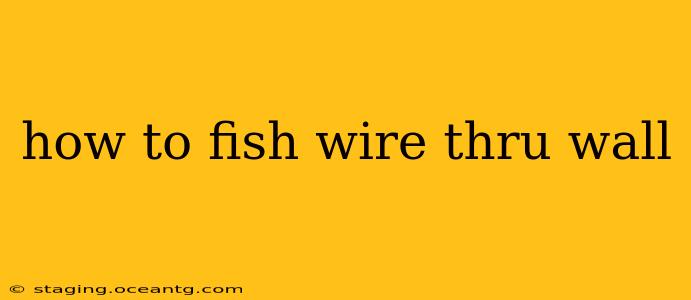Fishing wire through a wall is a common task for electricians, plumbers, and DIY enthusiasts. Whether you're installing new wiring, running cables for internet or phone lines, or simply need to access something behind the wall, this process requires careful planning and execution. This guide will walk you through the best methods, safety precautions, and troubleshooting tips to help you successfully fish wire through a wall.
What Tools Do I Need to Fish Wire Through a Wall?
Before you begin, gather the necessary tools. The exact tools may vary depending on the wall type and the wire's thickness, but generally, you'll need:
- Wire snake or fish tape: This flexible tool is crucial for navigating the wall cavity. Different types are available, including those with stiffer or more flexible ends, and some even have lights or cameras attached for better visibility.
- Drill with various drill bits: You might need drill bits for pilot holes, depending on your access points.
- Screwdrivers: To remove existing wall plates or access panels.
- Stud finder: Essential to avoid damaging electrical wiring, plumbing, or structural components within the wall.
- Safety Glasses: Protect your eyes from debris.
- Work Gloves: Protect your hands.
- Measuring tape: To accurately determine distances and locations.
- Flashlight or headlamp: To illuminate the work area, especially in tight spaces.
- Optional: A helper: An extra pair of hands can significantly ease the process.
How to Find the Best Path for Fishing Wire Through a Wall
Successfully fishing wire often hinges on finding the optimal path. Here's how:
- Locate Access Points: Identify where you'll enter and exit the wall. Existing electrical boxes, or even strategically placed holes, are ideal.
- Check for Obstructions: Use a stud finder to pinpoint wall studs and avoid them. Also be aware of plumbing lines, electrical wiring, and insulation. Accidental damage can lead to significant problems.
- Plan Your Route: Consider the shortest and most straightforward path. Avoid sharp bends or tight turns, as these can snag the wire.
What are the Different Methods for Fishing Wire Through a Wall?
Several techniques exist for fishing wire, each with its advantages and disadvantages:
Using a Wire Snake or Fish Tape
This is the most common method. Insert the snake or tape into the entry point, carefully guiding it through the wall cavity to the exit point. Attach the wire to the end of the snake and gently pull it through.
Using a Clothes Hanger
In a pinch, a straightened wire coat hanger can sometimes work, especially for thin wires or short distances. However, this method is less precise and more prone to snags.
Using a Vacuum Cleaner (Reverse)
This method is less common but can be effective in some situations. Connect the vacuum cleaner hose to the access point and turn it on in reverse mode. This creates suction that can draw the wire through. It works best with lightweight wires and relatively clear paths.
How to Attach the Wire to the Fish Tape?
Securely attaching your wire is key. Avoid using tape, which can fail under tension. Instead, consider:
- Wire Nuts: These provide a reliable connection.
- A small loop of wire: Create a loop on the end of your wire and hook it onto the fish tape.
- Specialized wire fishing attachments: These tools are designed to securely grip and release the wire.
What if I Encounter Obstructions While Fishing Wire?
Obstructions are common. Try these strategies:
- Try a different path: Sometimes, a slight adjustment in your route can solve the problem.
- Use a more flexible fish tape: Stiffer tapes are better for straight runs; more flexible ones are better for navigating obstacles.
- Use a smaller diameter wire: If possible, switch to a thinner wire to improve maneuverability.
- Carefully probe with a flexible tool: Gently feel around the obstruction to determine its nature and size.
How to Prevent Damage to Walls and Wiring
- Always use a stud finder: This prevents damage to critical structural elements and existing wiring.
- Wear safety glasses: Protect your eyes from flying debris.
- Work slowly and carefully: Avoid excessive force, which can damage walls or the wire itself.
- Use appropriate tools: The right tools make the job safer and easier.
Frequently Asked Questions (FAQs)
How do I fish wire through a finished wall?
Fishing wire through a finished wall requires extra care to avoid damaging the drywall. Use a smaller diameter wire and a flexible fish tape. Consider making smaller access holes as needed to facilitate the process. Repair any holes after successfully fishing the wire.
Can I fish wire through a cavity wall?
Yes, but cavity walls often present more challenges due to their construction. Plan your route carefully, and be aware of the possibility of obstructions. You might need to access the cavity from multiple points.
What's the best type of fish tape to use?
The best type of fish tape depends on the specific circumstances. For straight runs, a stiffer tape might be better. For navigating obstacles, a more flexible tape is needed. Some tapes have added features, such as lights or cameras, that improve visibility.
What size hole do I need to drill to fish wire?
The necessary hole size depends on the diameter of your fish tape and the type of wire you are fishing. Start with a small pilot hole and gradually enlarge it if necessary. Always err on the side of caution to avoid creating unnecessarily large holes.
How do I prevent damaging the existing wiring in the wall?
Use a stud finder to locate and avoid the existing electrical wiring, plumbing, and other obstacles in the wall. Carefully inspect the cavity before fishing wire to prevent damage.
By following these steps and taking appropriate precautions, you can successfully fish wire through a wall. Remember, safety and careful planning are crucial for a successful outcome.
